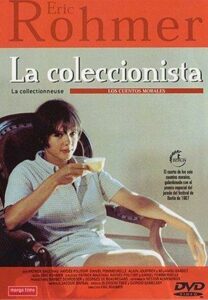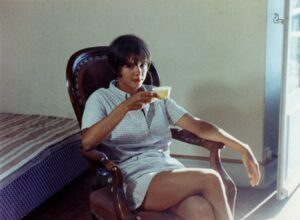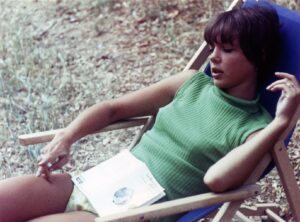“The Collector” – Eric Rohmer’s Moral Tale

Title: “The Collector” (“La collectionneuse”)
Release Date: 1967
Director: Eric Rohmer
Cast: Patrick Bauchau, Haydée Politoff, Daniel Pommereulle
“The Collector” from 1967 belongs to Eric Rohmer’s famous “Moral Tales” series, which follows the tradition of French drawing-room comedy. Thus, the main theme of the film here is the erotic adventures of the main character revolving in an elite circle, accompanied by an elaborate analysis of male-female relationships. In “The Collector,” a man is put in the situation of choosing between two women: one with whom he can form a permanent, serious relationship and the other, who is the object of his sexual fantasies.
“The Collector” – madonna or hussy?
Eric Rohmer is one of the most important filmmakers of the French New Wave. To the history of cinema has gone, first of all, his series “Moral Tales”, which consists of six films treating love dilemmas. In each of the links the main character is a man making a choice between two women: one of them is the epitome of sex, and the other of life stability. “The Collector” is Rohmer’s first feature film, and in addition, it was immediately appreciated by international critics, as demonstrated by the Silver Bear at the Berlin Film Festival.
The film tells the holiday story of Adrien (Patrick Bauchau), a budding manservant, spending the summer at his friend’s seaside estate. The man, tired of work, decides to spend his time on a pleasant laziness, lounging in the hot sun of Saint-Tropez. Although his girlfriend – a beautiful model – insists that he accompany her to London, he chooses the French Riviera, hoping for complete solitude. On the spot, it turns out that in addition to his acquaintance Daniel, the lovely Haydée, who is in an open relationship with the absentee owner of the estate, is staying at the house. The girl spends her time on more erotic adventures: each night she brings home a different lover. When Adrien begins to be disturbed by the noises coming from her room, Haydée decides to meet her admirers outside the house.

Soon all three household members become embroiled in an erotic game in which both men compete for the favor of a promiscuous girl. In the end, driven to the limits of nervous tension, Daniel decides to leave, and Adrien just before consummating a relationship with Haydée under the influence of chance gives up the relationship and returns to his girlfriend Carole.
“The Collector” – a new-wave work by Rohmer
“The Collector” formally refers to the tradition of French salon comedy. Thus, the plot is set in the affluent environment of the upper classes and concerns complicated sexual relations. In this regard, the director’s model is the work of a well-known French comedy writer – Pierre Carlet de Chamblain de Marivaux. Rohmer, as a New Wave filmmaker, introduced the characteristic features of this direction into the film. An element of naturalness is provided by the actors’ improvised dialogues. In addition, there is a first-person narration – Adrien gives a detailed account of his thoughts, which at times have the character of a philosophical disputation. In this way the director fulfills the task he believes cinema should fulfill above all, namely to show the human interior and the complex motivations of human action.
Of course, of great importance in “The Collector” is also the imagery – outdoor frames portraying the charms of Saint-Tropez, magnificently captured by a master in this profession: Nestor Almendros. The film interestingly contrasts the wild corners of the rocky coastline and azure sea with the hustle and bustle of the port town. The former scenery is suspended in a kind of timelessness, even boredom, which prompts the protagonist to deep introspection. The city, on the other hand, immediately dynamizes the action and forces the characters into external activity. Moreover, it is a space of civilization, taming the dark instincts that prevail over the protagonist when he is in close proximity to nature. It is in the city that Adrien makes the decision to part with Haydée, and his return to Carole is tantamount to leaving the province and returning to the city.

“The Collector” as an ironic portrait of the sexual revolution
The film “The Collector” shows the protagonist in a situation of moral choice, but although the man ultimately decides to return to a partner with whom he will be able to form a secure relationship, there is no serious moralizing here. Rohmer does not pass judgment and takes into account with understanding the perspective of a girl experimenting with sexual experiences. Haydée is not stigmatized, and her behavior is lined not so much by a hunger for eroticism as by a kind of confusion and search for her own path. What seems most interesting, however, are the hysterical reactions of the men to such an openly unprincipled woman’s attitude. They are the ones who cannot cope with Haydée’s total independence. The realization that they could be replaced by another admirer at any moment leads Daniel and Adrien to consternation. They have to confront unbridled femininity, because the traditional methods by which culture represses female sexuality, associating it with sin and transgression, do not work at all on this girl.
As a result, the men decide to run away. Daniel becomes Haydée’s next prey, and then tries to get his face back by pelting his lover with libations that sound like ineffective incantations from a bygone era, and leaves. Adrien, on the other hand, ultimately avoids entanglement in a complicated relationship and chooses the safe traditional option. Therefore, Rohmer’s “The Collector,” while portraying the moral changes of the younger generation in the 1960s, simultaneously maintains an ironic distance from them. It shows that the scenario of sexual freedom not subject to any restrictions is realized in the imagination and not in real life. Meanwhile, traditional morality is still doing well and, contrary to appearances, offers men far more benefits than the negation of monogamy, which staunch contestants officially find difficult to admit.
Literature:
„Kino epoki nowofalowej”, pod red. T. Lubelskiego, I. Sowińskiej i R. Syski, Kraków 2015.
A.Grabicz, „Kino, wehikuł magiczny. Przewodnik osiągnięć filmu fabularnego. Podróż trzecia. 1960 – 1966”.
